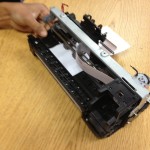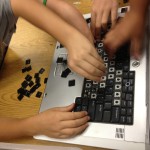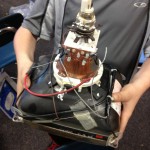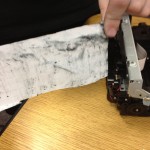Exploration Instruction: “Take It Apart Tuesday”
Exploration Instruction: “Take It Apart Tuesday”
A Great Strategy for Activating Your Students’ Curiosity & Innovative Creativity
The Point:
When students are allowed to explore things that interest them in ways that excite them they tend to engage in critical thinking and creative learning. Scaffolding exploration with effective instruction about the scientific process, introducing an umbrella focus topic, and allowing groups of students to guide their own learning through research, inquiry, and reflective processing can be incredibly effective in sparking their imaginations and supporting their growth.
The Story:
I first heard about “Take It Apart Tuesday” at a Community Education Meeting at Pierce Elementary School. One of the parents was reminiscing about this great activity that her kids used to do at “Kids Club” (the after school activities group). She was going on about how they “loved” exploring televisions, toasters, cell phones, and other gismos and gadgets by simply taking them apart. She made it sound like she was describing the latest new gaming craze. The cool thing is that she was talking about learning! It was one of those instructional ideas that grabbed me immediately. I promised myself that I would put it into practice soon. Turns out I didn’t have to wait. The incredible John Kernan made it happen with his fourth graders and invited me to participate. One of John’s great strengths is his ability to adopt new strategies, implement them into his instruction, and adapt them to meet his students’ needs along the way. In this case he gathered donations ranging from VCRs to iPads, brought in a bunch of tools, set up the initiative with scaffolding instruction about scientific exploration, reflective note taking, and next step planning, and thrust the practice into his “Simple Machines” unit of study. Perfect!
I have been amazed at the great process and the incredible (and ongoing) outcomes. To begin with, these fourth graders couldn’t be more enthusiastic about their science exploration. Of course, the wonderful modeling and enthusiasm from Mr. Kernan and the groups’ phenomenal paraprofessional Carol Maynard doesn’t hurt. Being in this class reminds me of just how important it is for educators to actively and overtly live their learning philosophies. Students really pick up on the energy of their teachers! Also, I’ve been hearing some really promising exclamations like, “So that’s how they do that!” and “Oh, I didn’t realize that’s how it fit together!” It’s this kind of stuff that leads me to believe that these explorers are engaged in some complex critical thinking. What an authentic opportunity for them to dig around into the world of simple machines. I’ve heard kids talking about the fact that it takes many simple machines to make up a more complex machine. I saw a group of kids re-assemble the printing mechanism of an old printer, put an ink cartridge in it, and roll a piece of paper through. It was if they discovered fire! The room was a buzz with congratulatory anecdotes about their work, like: “Can you believe that they actually figured out a way to print!” and “How Cool!”
One of my favorite moments was when a group discovered a QR code on one of the chips that they removed from a relatively old Dell laptop. They immediately accessed their scanning devices. iPads, iPods, and cell phones were flying out of pockets, ready to retrieve information for these excited learners. Turns out, the QR codes were too small. Mr. Kernan encouraged a few students to go down to the office and enlarge the codes in the copy machine. I love that he was adaptable in supporting their efforts! In the end, the codes led to product identification numbers. It was a bit disappointing for the students because they wanted a link to some company website that would enlighten them as to what the chip was for. However, in true explorer fashion, they gathered themselves and perpetuated a conversation about the implications of their discovery. Consequently, they’ve challenged themselves to research the history and evolution of QR codes, thinking that maybe this computer was built before companies began using the codes in the ways they do today. I am so impressed with the line of exploratory thinking and the students’ comfort with following a path of inquiry based on curiosities about the discoveries that they are making. Great instruction! Great Learning! Great Teaching! Great work!
The Take:
1. Inquiry instruction is often frontloaded with intense work both on the part of the teacher and the students. However, when teams of learners understand and are able to employ scientific exploration and research strategies the growth benefit is tremendous. Time taken to scaffold Project Based Learning (PBL) is time well spent!
2. Inquiry instruction can help to support the development of students’ imaginations, their creativity, and their ability to conceptualize innovation as real and relevant.
3. Reflective processing and critical thinking are essential to learning and growth. When teachers offer time, support, and encouragement to that effect, the transition from information to knowledge and understanding is enhanced.
4. When I keep my ears open for great instructional ideas they come. Listen, adapt, and partner with as many people as you can. Collaboration is among the best ways to grow as an educator, and it seems to offer the maximum learning benefit to the diverse group of students that we serve.
5. I can’t remember a new instructional strategy that worked exactly the way I intended it to. Some blow me away with incredible outcomes that I didn’t anticipate and some disappoint me by delivering poor results. However, I’ve never regretted trying something new, and with every new attempt I enhance my knowledge, my understanding, and my practice.
6. Reach out to the community…people are willing to donate stuff!
7. Taking things apart can help you learn about how they work.
8. Making connections is a key component of PBL and Inquiry. In order to successfully support student interest, systems and structures have to be in pace to ensure that those interests are explored in ways that connect to critical content and developmental skills.
9. Be the learner that you expect your students to be.
10. Let students veer off in organic directions. Manage the process so that enduring understandings and essential outcomes remain in focus, but allow for flexibility. True exploration has the potential to surprise the explorer. True discoveries are often unimaginable until they are uncovered!





